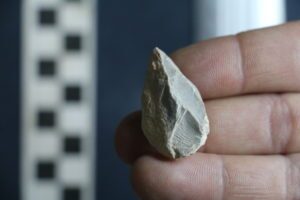
University of Cambridge and University of Copenhagen—A cave in a remote part of Mexico was visited by humans around 30,000 years ago – 15,000 years earlier than people were previously thought to have reached the Americas.
Painstaking excavations of Chiquihuite Cave, located in a mountainous area in northern Mexico controlled by drug cartels, uncovered 1,900 stone tools from a small section of the high-altitude cave.
Archaeological analysis of the tools and DNA analysis of the sediment in the cave uncovered a new story of the colonization of the Americas which now traces evidence of the first Americans back to 25,000-30,000 years ago.
The results, which have been published in Nature today (July 22 2020), challenge the commonly held theory that the Clovis people were the first human inhabitants of the Americas 15,000 years ago.
DNA scientist Professor Eske Willerslev, of St John’s College, University of Cambridge, and director of The Lundbeck Foundation GeoGenetics Centre, University of Copenhagen, led the study with archaeologist Dr Ciprian Ardelean, of the University of Zacatecas in Mexico.
Professor Willerslev said: “For decades people have passionately debated when the first humans entered the Americas. Chiquihuite Cave will create a lot more debate as it is the first site that dates the arrival of people to the continent to around 30,000 years ago – 15,000 years earlier than previously thought. These early visitors didn’t occupy the cave continuously, we think people spent part of the year there using it as a winter or summer shelter, or as a base to hunt during migration. This could be the Americas oldest ever hotel.”
The 10-year long research project raises more questions about the early humans who lived in the Americas than it solves.
Dr Ardelean said: “We don’t know who they were, where they came from or where they went. They are a complete enigma. We falsely assume that the indigenous populations in the Americas today are direct descendants from the earliest Americans, but now we do not think that is the case.
“By the time the famous Clovis population entered America, the very early Americans had disappeared thousands of years before. There could have been many failed colonizations that were lost in time and did not leave genetic traces in the population today.”
Chiquihuite Cave is a high-altitude site, 2750 meters above sea level. Nearly 2000 stone tools and small tool fragments, known as flakes, were discovered. DNA analysis of the plant and animal remains from the sediment packed around the tools in the cave dates the tools and the human occupation of the site to 25,000-30,000 years ago. Human DNA was not found which adds weight to the theory that the early people didn’t stay for long in the cave.
Dr Mikkel Winther Pedersen, a geneticist from the University of Copenhagen and one of the first authors of the paper, said: “We identified DNA from a wide range of animals including black bears, rodents, bats, voles and even kangaroo rats. We think these early people would probably have come back for a few months a year to exploit reoccurring natural resources available to them and then move on. Probably when herds of large mammals would have been in the area and who had little experience with humans so they would have been easy prey. The location of Chiquihuite Cave definitely rewrites what has conventionally been taught in history and archaeology and shows that we need to rethink where we look for sites of the earliest people in Americas.”
The Stone Tools
As far back as 30,000 years ago, humans had already developed techniques for producing tools. In this Mexican cave, researchers found 1,900 stone tools.
The unique feature of the Chiquihuite Cave is the “floor”, which consists of six layers of detritus and dust – all in all, a ten-foot column of ancient remains – which is so compressed and stable that by using various advanced measuring methods, it has been possible to date the layers one by one, from top to bottom.
Each layer has contained deposits of stone tools such as knives, scrapers and arrowheads, which the researchers have also been able to date.
“The cave finds are extremely interesting. These archaeological finds are so far the oldest in America. And the excavated stone tools are of a type unique to America,” Professor at Universidad Autónoma de Zacatecas, Mexico, Ciprian F. Ardelean, states.
Ice Cap Across North America
Until now, science has assumed that the earliest immigration to America took place approx. 15,000 years ago. At the time, a narrow opening in the ice along the northern Pacific coastline was created, which made it possible to walk from Siberia onto the American continent.
At the time, there were no other access routes to the continent, because North America was covered by a thick ice cap, which only later – approx. 13,000 years ago – melted enough to enable passage.
30,000 years ago, when the first stone tools were left in the Chiquihuite Cave, the massive ice cap had not yet covered all of North America, which means that it would have been possible to walk from Siberia and down through the American continent, Eske Willerslev explains.
The Chiquihuite Cave site is very difficult to reach and would have been a good vantage point for the early people to defend themselves from as they could look out for miles over the valley without being seen. It is in an area of Mexico that is now controlled by drugs cartels. The academics were escorted by armed police to the base of the mountain before they made their way up to the cave on foot.
Dr Pedersen said: “It was an unforgettable experience. It is a very unsafe place to travel so we were accompanied by Mexican police officers in armoured cars to the foot of the mountain. We left before sunrise to climb up to the cave so that we weren’t spotted.”
The visiting DNA scientists slept in the cave during their research visit and over the past 10 years Dr Ardelean has spent a number of months living in the cave to carry out the painstaking excavations.
Dr Ardelean added: “The peopling of the Americas is the last holy grail in modern archaeology. Unconventional sites need to be taken seriously and we need to go out and intentionally look for them. This site doesn’t solve anything, it just shows that these early sites exist. We are dealing with a handful of humans from thousands of years ago so we cannot expect the signals to be very clear. We have literally dug deeper than anyone has done in the past.”
The earliest human DNA from the Americas currently remains at 12,400 years ago, Dr Ardelean explained: “We have shown the previously long held date of human presence is not the oldest date for populating the Americas, it is the explosion date of populating the Americas.”
Professor Willerslev concluded: “I will never forget being part of this research, it was an unbelievable experience. The implications of these findings are as important, if not more important, than the finding itself. This is only the start of the next chapter in the hotly debated early peopling of the Americas.”
________________________________
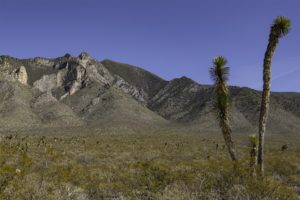
View of the Sierra El Astillero mountains where the Chiquihuite cave was found in 2012. Devlin A. Gandy
________________________________
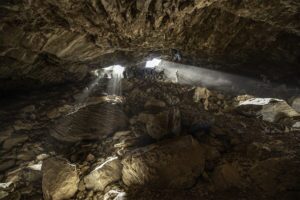
Team members entering the Chiquihuite cave. Devlin A. Gandy
________________________________
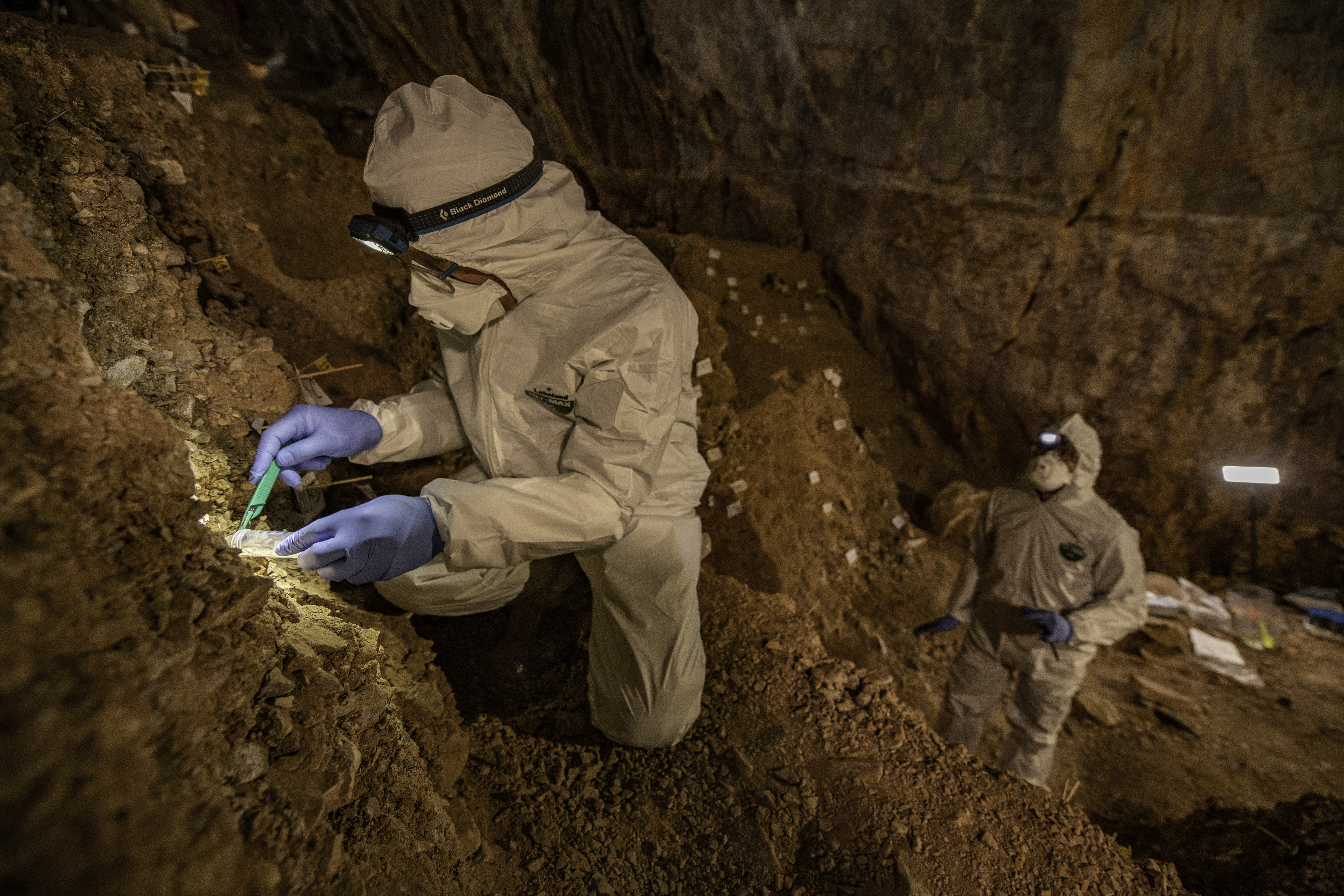
Assistant professor Mikkel Winther Pedersen from the University of Copenhagen sampling the cave sediments for DNA. Devlin A. Gandy
________________________________
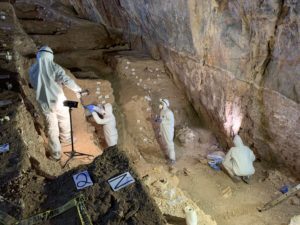
Assistant professor Mikkel Winther Pedersen with team members carefully sampling the different cultural layers in the cave. Mads Thomsen
________________________________
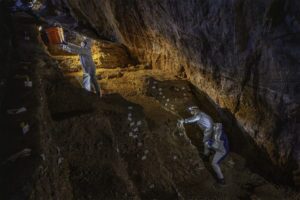
Assistant professor Mikkel Winther Pedersen with team members carefully sampling the different cultural layers in the cave. Devlin A. Gandy
________________________________

Stone tool found below the Last Glacial Maximum (LGM) layer, within Stratigraphic Component C, at Chiquihuite Cave. Ciprian Ardelean.
________________________________
Article Source: Edited and adapted from news releases of the University of Copenhagen and St. John’s College, University of Cambridge
________________________________
Advertisement


